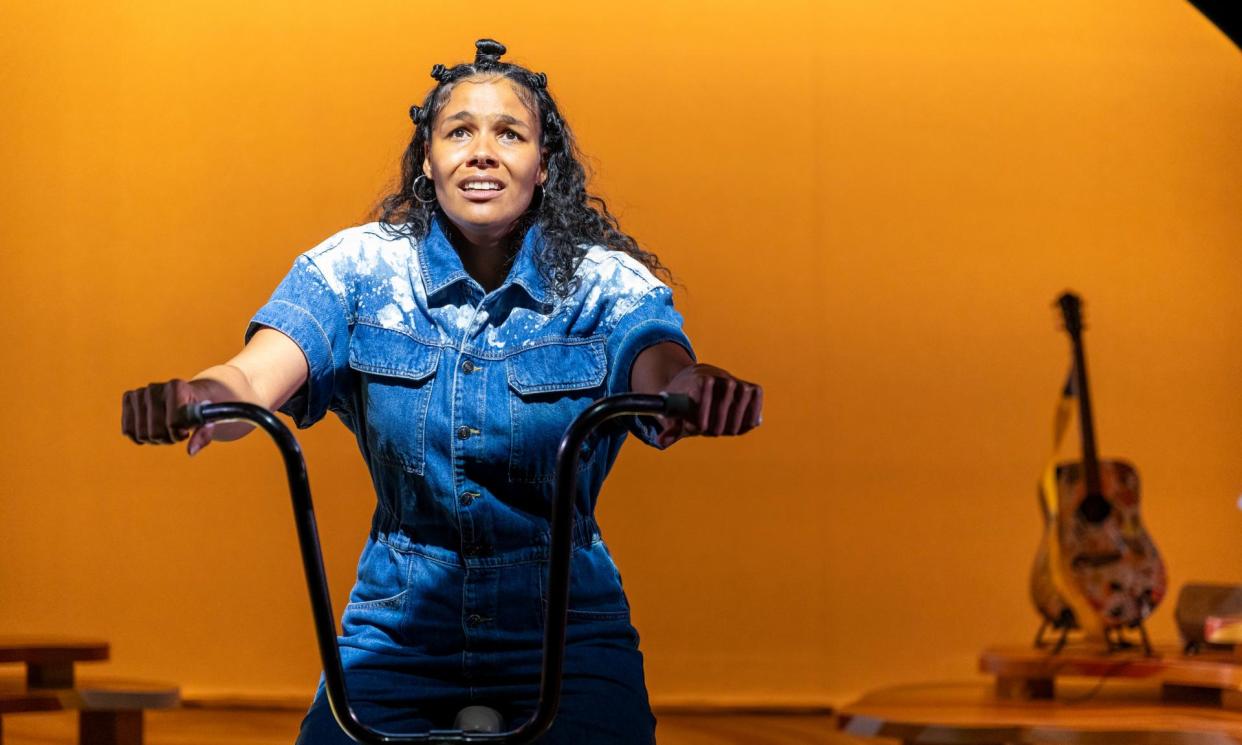The Hate Race review – Zahra Newman is brilliant in Maxine Beneba Clarke’s one-woman show

Maxine Beneba Clarke’s 2016 memoir The Hate Race was a powerful and harrowing account of a Black girl’s childhood in suburban Australia in the 80s and 90s. Lyrical and furious, it put the Sydney-born, Melbourne-based poet on the map as one of our finest storytellers. The Hate Race has since become part of high school curricula, cementing its importance as a story from the diaspora.
The stage adaptation, also written by Clarke and co-directed by Courtney Stewart and Tariro Mavondo, is a different yet equally moving experience. The stage, designed by Zoë Rouse, is simple: an abstract-patterned floor with several low platforms dotted around it, a large half-moon backdrop and a lone acoustic guitar at the back. Occasionally, travelling light splits the stage, vanishing as quickly as it comes.
We begin, as in the book, with Maxine in the present, on a walk with her children when she is subjected to racism by a stranger. Then, a flashback to her childhood growing up in conservative suburban Sydney to a Jamaican father and Guyanese mother: when the racism was both direct and casual, and internalised by Maxine before she journeys towards self-acceptance.
Related: Zahra Newman on becoming Billie Holiday: ‘I want people to feel how they do when they listen to her’
All the characters in Clarke’s story, from Maxine herself to her family and peers, are played by Zahra Newman, who also read the audiobook of The Hate Race. Newman is no stranger to a one-woman show, having portrayed Billie Holiday in Lady Day at Emerson’s Bar & Grill last year and the Sydney Theatre Company’s upcoming solo production of Dracula this year. Her range is brilliant – she’s as convincing as a chatty young child as she is a broad-accented teacher, merciless schoolyard bully or Patois-speaking Jamaican elder.
At one point, Newman rapid-fires snippets of dialogue from a fast-moving conversation between multiple characters – it’s impressive and mesmerising. She’s having fun with it, too, with some audience interaction that doesn’t break character, and one moment where her laughter, an essential part of the scene, feels completely genuine. Having all roles played by Newman brings out the claustrophobia within Maxine’s head – it’s a smart choice for this show, while also showcasing one of Australia’s best working actors.
The only other person on stage is Kuda Mapeza, who serves both as musician (their honey-toned voice is gorgeous) and as an echo of sorts to Newman, providing whoops and onomatopoeic sounds. Clarke’s background as a spoken word poet is most evident here in the blend of techniques and textures; Mapeza’s character could also be seen as a spiritual guide or friend, or perhaps even another part of Maxine herself. The role of music in this story is pivotal, as both a sorrow and joy.
Maxine’s childhood is, in many ways, typically Australian – she loves Cabbage Patch Kids (the surprise appearance of one such doll, one of the only on-stage props, is a delight), hates John Farnham and eats Women’s Weekly recipes. Pop culture references pepper the show – Mapeza’s rendition of Frente!’s 90s single Accidently Kelly Street, accompanying Maxine’s daydream of what her life would be like if she were white, is a highlight.
She doesn’t see herself as different, but eavesdropped conversations between her parents reveal their fears for their children and their loneliness as migrants. Newman’s embodiment of Bordeaux, Maxine’s father, is especially commanding.
Indeed, despite Maxine’s largely happy childhood, the shadow of racism is always around the corner, and manifests in different ways throughout the show. Unlike the book, Clarke has made the choice here to omit racial slurs, and the show’s most potent scene is made all the more so with their implication.
Related: The accumulative effects of racism: it eats away at the essence of your being
Maxine, now in high school, tries to go to the bathroom but bullies block the way, commanding her to tell them “what you are”. “Say the word,” they repeat, and the moment builds in intensity before cutting out. Rachel Lee’s lighting and Dan West’s sound design work in tandem to create an incredibly tense atmosphere – backlit, Newman’s eyes are wild, flashing almost white as she becomes something else entirely. It’s a shame, then, that a scene where Maxine becomes the racist bully herself has been somewhat diluted in this adaptation – a confronting moment in the book that lands with less force on stage.
For a story that is so deeply steeped in trauma, this show is often very funny. That mix of humour and seriousness is what makes the stage adaptation of The Hate Race so compelling and real. As Clarke writes throughout her book: “This is how it happened, or else what’s a story for.”
The Hate Race is on at the Malthouse until 17 March


